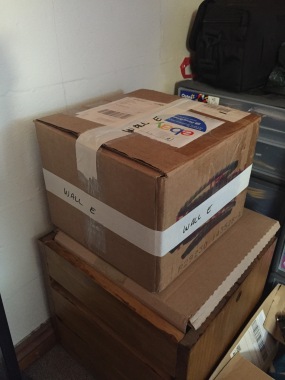This is Wall – E.
Today he got packed up in a box and placed on a shelf.
This Wall E is a project I’ve been working on for around 14 months. The inspiration came form my receiving my own desk at work and looking for toys to fill it. I stumbled across a few of these projects and promptly got very excited. The project involved gutting a bought Wall E toy and outfitting it with new, higher quality servos and a microcontroller (as well as a slew of other possible peripherals).
This weekend I found my progress was a case of one step forwards, two steps backwards. Which is not a negative thing really. It shows I have a more comprehensive understanding of the requirements of the project. Upon this reflection I’ve decided at this stage to bow out.
Wall E is now on the shelf with my other failed and/or unfinished projects. That’s the trouble ambitious ideas. I’ve a history of jumping the deep end to learn to swim. My hobbies are never small feats, small goals or easily attainable. They seem to involve a large investment of time, money and emotional turmoil. My last project before Wall E I build a Fender Jazzmaster. It’s not perfect, but it’s finished and I’m stoked with it.
With Wall E I’ve had to decided when it was OK to call it a day and realise where I start to be affected by the Sunk Cost fallacy.
I have learned so much in this process, and while there were times of confusion and frustration it has been on the whole a positive experience. I learned a lot and had a lot of fun.
I learned to feel pride in my own craftsmanship.
I learned to move slowly and in a calculated way.
I learned the value of research and learning from others’ mistakes and successes.
I delved into the dark art of coding for a microcontroller. Which is essentially learning a new language.
I amassed a collection of tools.
I discovered the world of hobby craft, the makers community, and prop making.
I learned that there are amazingly intelligent, skilled, and kind people out there only more than willing to share.
I’ve had to step back, realize I was in too deep and move on. I realized I was not prepared to get in even deeper and invest the time, money brain power and frustrations. I hit my limit. All things pass.
Sure there’s the thinking of “quitters never win”, but I still achieved a hell of a lot, and you’ve got to try these things. How else will you know what you’re capable of?
Yes, I’m disappointed, but not in myself. I’m disappointed in the fact that the project goes unfinished. This project was stopping me from growing, expanding, and taking on new interests and new ideas.
I’ll start a new project, a new idea, and another, and another, and another. Some with be finished, some won’t. Some will work out, and some won’t. That’s life. That’s learning. That’s growing.
















 I invested in this release based on countless columns in free music magazines.
I invested in this release based on countless columns in free music magazines. This is an easy to listen to rock album.
This is an easy to listen to rock album.







 When I heard that Yellowcard were back working together, I was quite excited. When I finally got my hands on the new release, ‘When You’re Through Thinking Say Yes’, I could not have been happier with the effort.
When I heard that Yellowcard were back working together, I was quite excited. When I finally got my hands on the new release, ‘When You’re Through Thinking Say Yes’, I could not have been happier with the effort.
 The first interesting thing about this E.P. is in the title, ‘H & H’. Looking at the track listing we notice that there is two tracks entitled ‘H’. As dramatic, film inspired instrumentals (an introduction and an interlude) the ‘H’s act like bookends, separating the tracks and also cleansing the ‘auditory pallet’. This interesting concept lends the song titles to the name of the E.P. ‘H & H’. An interesting concept.
The first interesting thing about this E.P. is in the title, ‘H & H’. Looking at the track listing we notice that there is two tracks entitled ‘H’. As dramatic, film inspired instrumentals (an introduction and an interlude) the ‘H’s act like bookends, separating the tracks and also cleansing the ‘auditory pallet’. This interesting concept lends the song titles to the name of the E.P. ‘H & H’. An interesting concept.